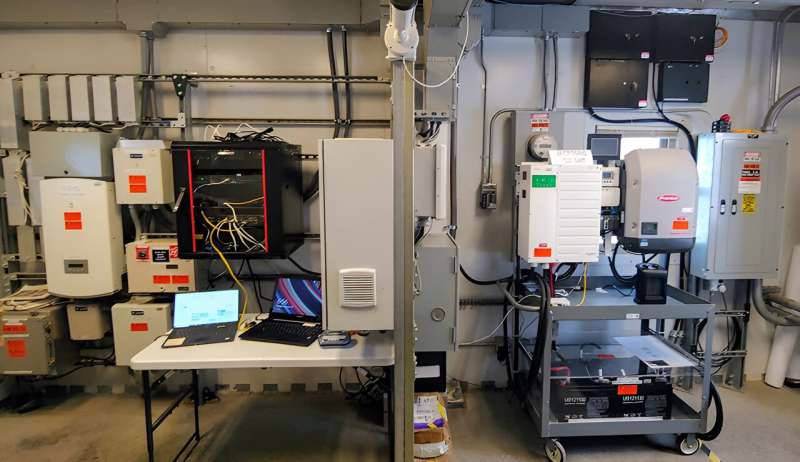
JUNE 3, 2024 by Connor O’Neil, National Renewable Energy Laboratory
Collected at : https://techxplore.com/news/2024-06-explore-setup-5g-microgrids-sandbox.html
Whether it is coincidence or careful planning, the infrastructures of both power systems and telecommunications are heading in a similar direction: toward the edge. Solar panels on a roof are like 5G towers in a neighborhood—in both cases, distributed assets increasingly underpin these important systems.
To study the newest generation of wireless communications and what it offers power systems, the National Renewable Energy Laboratory (NREL) built a 5G research platform inside a replicated military microgrid and put it through resilience scenarios and cyberattacks, publishing their results in a report titled “5G Securely Energized and Resilient.” They found that 5G features can support distributed controls and configurable security and resilience for power systems.
The project is part of the FutureG program, which aims to ready the nation for next-generation telecommunications platforms, especially for the security, automation, and resilience aspects. But the results go well beyond defense: NREL showed how utilities might use 5G to the benefit of network security, recovery, and costs. And now with a realistic communications testing ground at NREL, partners can ensure utilities will function when most needed in contested environments.
No wires, no problem
A little lag is annoying during a stream, but it can be debilitating during critical energy operations. The target speed for autonomous power restoration is 8 milliseconds—that is extremely fast. Hardwired fiber optics are the go-to alternative, but with such growth in distributed energy devices, laying fiber throughout a microgrid quickly becomes cost prohibitive. Instead, the project team explored how 5G ultralow latency might fill the gap.
“From a grid integration standpoint, many devices will need low latency and high reliability to successfully coordinate,” said Tony Markel, an NREL senior researcher and project lead. “A fundamental difference between 4G and 5G is the way the data moves; data resources can be closer to the edge. What if we harness the power of edge compute and reduced latency to make the grid components a more effective system?”
NREL researchers achieved some of 5G’s effectiveness by designing the microgrid to maintain power to both communications and critical loads. This included a layer of resilience that was added by using edge controllers to maintain microgrid component operation, even if some communications were unavailable.
With resilience and energy management both critical to NREL and DOD missions, this work found the combination of 5G, distributed controls, and a renewables-based microgrid to be a powerful combination.
Network resilience, priority traffic, and private slicing: Some 5G benefits
To evaluate 5G in credible operating conditions, NREL modeled its microgrid to reflect a military base in California. Identical solar arrays, battery systems, vehicle chargers, and protection equipment were modeled with interfaces via the 5G network. Many scenarios were tested, including grid outages and various cyber intrusions.
“Our test scenarios were not only about controlling the power grid and microgrids for resilience but also about powering the 5G network itself. If we can keep the grid running for resilient power, that in turn keeps the communications network operational,” said Brian Miller, electric power systems engineering lead.
The scenarios included failure of a cell tower, a microgrid controller crash and recovery, unsecure foreign-operated network traffic, and congestion from other network devices.
“Edge computing, network traffic prioritization, and private slicing all worked out,” Miller said, discussing 5G features that they implemented in the test microgrid. “We could operate flawlessly with this network; for example, prioritization allowed us to preempt even when communication traffic was maxed out, so that it’s like having dedicated access to critical systems.”
Latency, however, was less impressive. Perhaps with millimeter wave 5G bands the researchers would achieve significantly faster exchanges of data, but the geographically dispersed microgrid required the longer range of sub-6-GHz bands. Latency was low, but not ultralow enough to smoothly coordinate power restoration without even a blip in power, as a battery backup unit would typically provide.
With regards to security, researchers focused on each 5G component and found many ways to make the network more secure against attackers with a foothold. As 5G is built on commodity server hardware and virtualized tools and functions, each component requires a thorough cyber assessment and tuning to prevent threat actors changing data or reading parameters of energy systems. Knowing that the network components and data flows are secure is step one in being able to trust 5G for future uses with distributed assets.
A new lab capability
This 5G lab capability exemplifies collaboration across government agencies for a technology that achieves mutual resilience. 5G has special importance to DOD with its possibility to support numerous rapid deployment scenarios such as expeditionary air base operations, agile combat employment, and more. With further testing, these results will serve as a foundation for military services to enhance infrastructure. In the broader picture, 5G research contributes to resilient homeland electrical grids and U.S. innovation.
“We plan to use this project as a development platform for research capabilities that can be replicated in the Advanced Research on Integrated Energy Systems (ARIES) Cyber Range,” Markel said. “The 5G core, multi-access edge compute, private slices—provides the foundation for research plans in large-scale secure integration of renewables.”
ARIES is the ideal research environment for utilities, device developers, energy service providers, and any grid researcher to stage their own systems and validate 5G solutions without the limitations of doing tests directly on the public grid.
“Industry led these efforts by planning a modular and open 5G architecture, and we are researching new ways to use its features in the electricity grid,” Markel said. “Millions of energy devices will become interconnected, and our research is showing the path to distributed, resilient, secure, and energy-efficient operations building on the 5G foundation.”
More information: 5G Securely Energized and Resilient: Task 2 and 3 Progress Report. www.nrel.gov/docs/fy24osti/87180.pdf

Leave a Reply